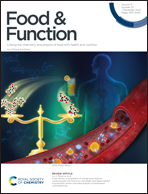Lactobacillus rhamnosus GG supernatant promotes intestinal mucin production through regulating 5-HT4R and gut microbiota†‡
Abstract
Lactobacillus rhamnosus GG (LGG) is a well-known probiotic widely used in foods and drugs. It has been reported that LGG can improve bowel dysfunction in gastrointestinal motility disorders, such as constipation; however, the specific mechanisms remain unclear. The colonic mucus layer is mainly composed of mucin secreted by goblet cells, which plays important roles in lubricating colonic contents and maintaining normal defecation function. It has been reported that increased mucin production is beneficial for relieving constipation symptoms. In this study, we aimed to investigate the role of LGG in regulating intestinal mucin production and the associated mechanisms. Six-week-old C57BL/6J mice were randomized into 3 groups, and were treated with De-Man Rogosa and Sharpe broth (MRS group), tegaserod maleate (tegaserod group) and LGG supernatant (LGGs group) by gavage, respectively. After treatments, defecation parameters, intestinal mucin-2 (MUC2) and serotonin 4 receptor (5-HT4R), goblet cells, and microbiota composition of the mice in each group were assessed. In comparison with the MRS group, higher fecal water content and increased fecal pellet number were found in the tegaserod group and LGGs group. Moreover, LGGs increased the number of goblet cells and upregulated the expression of 5-HT4R and MUC2 in the mouse colon. In addition, Alcian Blue Periodic acid Schiff staining showed that activated 5-HT4R enhanced intestinal MUC2 secretion. Further exploration of the mechanism discovered that LGGs upregulated intestinal S100A10, which was found to be involved in regulating 5-HT4R expression. Furthermore, gut microbiota analysis showed the higher abundance of Alistipes, Allobaculum, Desulfovibrio, and Clostridium XlVa in the LGGs group, which have been reported to be involved in regulating gut motility and the intestinal barrier, and alleviating bowel dysfunction. Interestingly, gut dysbiosis was present in the tegaserod group. It is noteworthy that the fecal microbiota transplanted from LGGs-treated mice significantly improved the gut dysmotility in a constipation mouse model. Our results suggested that LGGs could upregulate 5-HT4R to promote MUC2 production, as well as modulate the gut microbiota, thus improving the defecation function in mice. This finding might provide evidence for the application of diet supplementary LGG in relieving gastrointestinal motility disorders.



 Please wait while we load your content...
Please wait while we load your content...